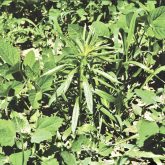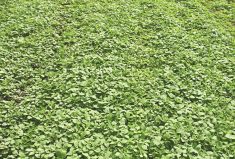Every decade or so since the mid-1970s, scientists at Agriculture and Agri-Food Canada (AAFC), with the help of many others, have co-ordinated and compiled weed surveys in each of the three Prairie provinces, counting, mapping, noting changes and marking trends.
The most recent survey was conducted in 2014 and 2015 in Saskatchewan, with financial assistance from Western Grains Research Foundation (WGRF), the Saskatchewan Agriculture Development Fund, the Saskatchewan Pulse Growers and others.
“The last time we did it here was in 2003,” says Julia Leeson, weed monitoring biologist with AAFC in Saskatoon and the principal investigator with the survey.
Read Also

Sensing the soil: Root cell research finds ‘stress hormone’
Research into how root cells react to soil stressors could help plants better adapt to changes in their climate.
Weed populations change gradually, so the roughly 10-year gap between surveys is ideal for revealing trends and changes in weed composition, density and distribution.
The 2014-15 Saskatchewan weed survey showed that the top three most abundant weeds — green foxtail, wild oats and wild buckwheat — are still the top three, in that order, as they have been since surveying began in the 1970s.
But Leeson noted some pretty big changes, too. “Canola moved up to the No. 4 position from No. 14,” she says, adding that it ranked within the top four weeds in all crops except canola, mustard and oats. “But that’s not too surprising when you look at how canola acreage has expanded. It’s actually the No. 1 weed in pulses.”
Seeing kochia on the move northward is also not too surprising, but that it held steady in the No. 15 position is perhaps a bit of a stumper until you remember how wet 2014 was. Those conditions, says Leeson, would have knocked kochia back during a survey year, skewing the results a bit.
“I suspect it’s more abundant than this shows,” she says, adding that kochia’s expanding range and herbicide-resistant populations are still big causes for concern.
There were a few lesser-known weeds that raised some eyebrows. Spiny annual sow thistle, for example, clocked in at No. 6. “That was surprising because it came up so far, a full 28 spots from the last survey,” says Leeson. It’s one of four weeds that have been on a steady rise since the ’70s, the others being barnyard grass (No. 12), round-leaved mallow (No. 22), canola and false cleavers.

Up 33 spots since the ’70s
With false cleavers now taking the No. 7 spot (up six places from 2003), we see a prime example of what surveys can tell us about how the weed landscape changes over time, says Leeson. “It’s gone up 33 spots since the ’70s.” She attributes this to range expansion and says that further movement south was documented in the 2014-15 survey. The weed is now in the top seven for spring wheat, canola and barley growers, and in the top 25 for durum, oats, flax and peas (it’s No. 26 in lentils).
Leeson also has her eye on the No. 9 weed, narrow-leaved hawk’s-beard. “It’s had a huge geographical shift since the last survey,” she says. “It went from being found only in the northwest to everywhere. It started to increase in the ’90s, which correlates to the widespread adoption of conservation tillage.”
That kind of information is more important than it might seem at first blush. A leap in abundance of some weed species can be an early warning for resistance-management challenges to come, because resistance is, generally speaking, a numbers game — the more abundant a weed is, the higher the chances of resistance developing.
And while it’s interesting to learn which weeds are moving up in the overall rankings, Leeson says that that’s just one part of the picture. “Producers fill out a management questionnaire so we can look at their data and link it back to the weeds in their fields,” she says.
This layering of knowledge — understanding how different crops and management systems affect weed populations and distribution — is at the heart of why AAFC does weed surveys and why it’s important work.
Leeson says there are 182 weed species in the Saskatchewan database alone. Having all that historical information to draw on and using it to see how weeds are changing over time, and how farming practices and inputs may be influencing those changes, helps weed scientists develop studies aimed at finding sustainable management solutions that farmers actually need.
It would be easy to get complacent about weed surveys. Let’s face it — this isn’t the “sexy” kind of science that will lead to some snazzy technological breakthrough.
But it is foundational science that, oddly, sometimes struggles for funding, despite the important weed research that it underpins. “This survey wouldn’t have gone through without WGRF,” says Leeson. “People all over the world are envious of what we do here. The weed survey data is used to justify and direct weed research so that it’s beneficial to farmers.”
The following funders supported the 2014-15 Saskatchewan weed survey:
- Western Grains Research Foundation
- Saskatchewan Agriculture Development Fund
- Saskatchewan Pulse Growers
- Saskatchewan Ministry of Agriculture
- Canada-Saskatchewan Growing Forward 2
WGRF is a farmer-funded and -directed non-profit organization investing in agricultural research that benefits western Canadian producers. For 35 years the WGRF board has given producers a voice in agricultural research funding decisions. WGRF manages an Endowment Fund and the wheat and barley variety development check-off funds, investing over $19 million annually into variety development and field crop research. WGRF is the largest producer funder of research in Canada.















